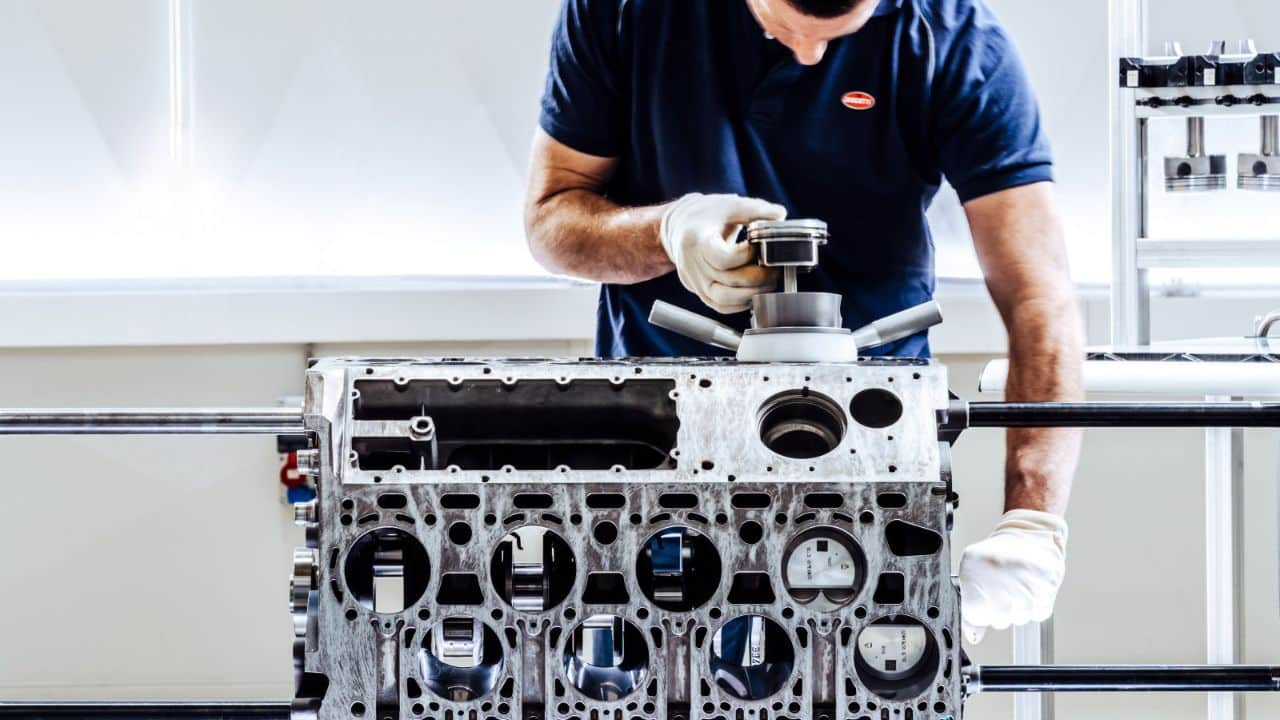13 Craziest Engines Ever Made

The engine is as important to a car’s operation as the heart is to a human being. Without the heart, there’s neither life nor movement. In fact, most cars require turning on the ignition for seemingly nonessential features like windshield wipers and seat adjustments to work.
For this reason, automakers, engineers, and designers have worked tirelessly throughout automotive history to push the boundaries of engine technology. Some took things a step further while others challenged expectations and at other times defied convention by creating what people in our day might call “sick” or “crazy.”
Naturally, that’s how we define engines that manage to redefine the limits of performance, whether in terms of efficiency, combustion, or raw power. These 13 engines represent the pinnacle of ingenuity and ambition.
Bugatti W16 Quad-Turbo

- For the Bugatti Veyron and Chiron
This 8.0-liter W16 produces over 1,106 lb-ft of torque and 1,000-hp with the help of four turbochargers. It’s pretty much one of the ‘craziest’ and most powerful engines the automotive world has ever seen.
The design joined two narrow-angle V8 engines in a “W” configuration. An arrangement of four banks of four cylinders creates a more compact 16-cylinder unit versus traditional V16s. Bugatti went further by assisting the engine with four turbos arranged sequentially. Two are active at low RPMs and all four kick in at higher RPMs to maximize power.
All told, the Bugatti W16 Quad-Turbo makes 1,200-hp (in the Veyron Super Sport) and 1,479-hp in the Chiron. Anticipating the immense heat, Bugatti resorted to carbon fiber and a sophisticated multi-radiator (ten for the Veyron) cooling system.
Mazda 13B Rotary Engine

- For the Mazda RX-7
The 13B Rotary’s Wankel design made it one of the craziest engines ever made. The design achieved a remarkably high power-to-weight ratio and a sound unique to the Mazda RX-7.
Wankel differs from piston engines by using triangular rotors that move in an epitrochoidal path inside the engine housing. The result is an extraordinarily smooth and high-revving operation of over 8,000 rpm. The engine’s compact design contributes to a lower center of gravity, ergo, the RX-7’s improved weight distribution.
The craziest part is, perhaps, that this seemingly small engine could produce 280-hp. The high rev and lower center of gravity are just the recipe for fun-to-drive sports cars.
Unfortunately, the rotary engine had a deal-breaking design flaw that required Mazda to develop specialized apex seals to maintain compression and prevent oil leakage. It also proved more complicated to manage the intense heat the engine generated.
Chrysler HEMI V8

- For the Dodge Charger and Challenger
The HEMI contributed immensely to the glory of Detroit to the extent that we can confidently say America’s automotive history would be radically different today had Chrysler’s FirePower engine series not birthed the HEMI engine in the early 1950s.
The name, like the W16, is self-explanatory — it features hemispherical combustion chambers unlike the traditional flatheads also known as side-valve engines. The flathead was a simpler design and cheaper to make, but the pursuit of ‘FirePower’ led to the more sophisticated HEMI V8 for muscle cars like the Dodges and Plymouth Barracuda. In fact, the HEMI has since traveled beyond automobiles to marine and aircraft engine bays.
They were more powerful because the hemi-shaped pots could take larger valves and allowed a more efficient air-fuel mixture burn. The valve arrangement meant the intake and exhaust valves sit at opposite sides of the chamber, so the chance of hot spots is lower and there’s better airflow.
Ferrari F140 V12

- For the Ferrari LaFerrari
This is the 6.5-liter V12 engine that blessed the LaFerrari with a staggering 950-hp. If the F140 will be wiped from the annals of the world’s most historic engines, that day isn’t today. It’s a free-breathing 65-degree V12 respected for its remarkable design and exceptional performance.
Setting a benchmark for naturally aspirated performance engine design, each cylinder has its own throttle body while its variable valve timing optimizes performance and efficiency across different RPM ranges.
The high displacement of 6.5 liters allows substantial power and torque as much as the lightweight aluminum and titanium construction optimizes performance and durability. It debuted in the Enzo with 651-hp on tap, while the 812 Superfast upgraded it further to produce 789-hp. The LaFerrari paired it with the HY-KERS hybrid system to deliver 950-hp.
Rolls-Royce Merlin V12

- For Dodd’s Beast
The Merlin was originally a WWII aircraft engine adapted for automotive applications in models like The Dodd’s Car. Imagine adaptations of the Spitfire and Lancaster bomber’s 1,500-hp heart under the hood of 4-wheeled automobiles. The later versions used a two-stage supercharger that was particularly handy for dogfighting at high altitudes.
Automakers like Paul Jameson would soon want a piece of the 27-liter, liquid-cooled Merlin V12 and developed the legendary “Beast” around a decommissioned Merlin.
Thanks to the Merlin, the Beast entered the Guinness Book of World Records as the most powerful road-legal car at the time, capable of — as some say — around 183 mph top speed. The engine’s sound is itself a piece of history.
BRM H16

- For F1 Racing Cars
The BRM H16 is a 1960s 16-cylinder F1 engine that combined two flat-eight engines with a common crankshaft stacked on top of each other to create an “H” layout. It was an extremely rare and complex engine configuration, although the goal was to create a more compact 16-cylinder unit compared to traditional V16 engines.
The F1 car’s stringent packaging constraints made the H configuration a welcome, albeit crazy solution.
Needless to say, the BRM H16 was not an easy engine to build, maintain, or repair, thanks to the double cranks, multiple cams, and complex details. Furthermore, the designer failed to create a lighter engine despite the BRM H16’s compact goals.
Koenigsegg Freevalve Engine

- For the Koenigsegg Regera and Jesko
As its name implies, Koenigsegg’s free-valve technology is a cam-less design that allows for infinitely variable valve timing, duration, and lift because each valve is independently controlled. It uses electro-hydraulic-pneumatic actuators whereas the typical ICE uses camshafts to control the opening and closing of valves. With no cams and all the other components that work with it, the unit has less components and therefore lighter and less complex. It also means no parasitic losses, so the engine runs more efficiently.
What’s ‘crazy’ about this is that the precise, individually operated valves allow unparalleled flexibility in engine operation. With precise control of the valve timing and lift, the engine is a tuner’s delight, whether for more power or fuel efficiency or both.
BMW M12/13 Turbo

- For F1 Racing Cars
The BMW M12/13 Turbo is an F1 engine of extraordinary performance, producing over 1,400-hp in the 1980s. Its 1.5-liter 4-cylibder configuration was atypical of F1, and so was its lone KKK turbocharger in the ‘80s F1 competition. The norm was larger-displacement, multi-cylinder engines in the pursuit of maximum power.
However, the M12/13’s compact dimensions brought the advantage of optimized weight distribution and packaging. Depending on the boost settings, it delivered 800 to 1,000-hp to become one of the most potent engines to ever compete in Formula One.
It ran at extremely high boost pressures often exceeding 5 bar (around 73 psi) in qualifying. The craziest part, if you ask us, is that road-going Bimmers (the 1960s M10 engine, specifically) provided the foundation for the M12/13’s engine block.
Napier Deltic

- For Marine, Locomotive, and Industrial Applications
This is an opposed-piston, three-crankshaft diesel engine where three banks of cylinders are arranged in a triangle, with each bank containing opposed-piston cylinders. That means there are two pistons in each cylinder moving in opposite directions, ultimately making cylinder heads redundant.
While not a typical automobile engine, the Napier Deltic deserves a mention in this list due to its unique, innovative design features, particularly its tri-radial configuration. This entails a 3-cylinder, 2-stroke design configured like a triangle, unlike the traditional straight, V, or flat layout.
The engine found applications in marine (such as naval vessels), locomotives (such as the British Rail Class 55), and industrial machine (such as electricity generators) uses.
Volkswagen W12

- For the Bentley Continental GT
The Volkswagen W12 achieved instant fame with its unique “W” design, serving as a technological and engineering foundation for the famous W16 under the hood of the Veyron and Chiron supercars.
It powered famous models under VW’s umbrella, including the Audi A8, Bentley Continental GT, and Volkswagen Phaeton. In fact, VW built a series of concept cars of the same name to showcase this engine’s capabilities.
The 5.6-liter unit produced around 600-hp, which was pretty impressive at the time, sending the concept car from zero to 60 mph in 3.5 seconds and a top speed of around 220 mph. The design is a similar concept to the W16 except that the W12 featured two V6 units with a 15° angle between them to form the “W” configuration.
Cadillac V16

- For the Cadillac V-16 Series
The Cadillac V16 is on this list of crazy engines because it is — we dare say — as impressive as it is one of the most iconic engines in Cadillac’s history. Introduced in the 1930s, the 7.4-liter 9452 cu-in) Cadillac V16 was good for around 165 to 185-hp, a decidedly extraordinary output for its time.
The 16 pots formed a “V” shape by combining two V8 engines into a single block. Its smooth and robust power generation capabilities made it the most fitting candidate for Cadillac’s top-of-the-line models such as the 452 and 90 V-16-Series luxury cars. Cadillac built the V16 for just ten years between 1930 and 1940 before the Great Depression forced its expensive production to a halt.
Honda RA168E

- For F1 Racing Cars
The Honda RA168E is a legendary 1.5-liter turbocharged V6 Formula One engine that cranked out up to 700-hp during the late 1980s. Honda developed it an anticipation of the 1988 F1 season, and there was even a unit that made over 1,000-hp. The power output aside, the RA168E would soon be known for its exemplary durability, giving the McLaren-Honda team’s Ayrton Senna and Alain Prost the much-needed advantage to win 15 out of 16 races that year.
Nothing could’ve been crazier. It’s not every day you meet a reliable engine capable of such astronomical horsepower figures. The engine’s advanced techs included a pneumatic valve system for optimized revs and power. Unfortunately for Honda, Formula One banned turbocharged units after the 1988 season.
Chevrolet LS7

- For the Corvette Z06
The LS7 needs no introduction among gearheads, sports car enthusiasts, and Chevy/GM fans. It is a member of the LS family of engines, from the Gen III LS1 (debuting in the C5 Corvette, Pontiac GTO, Camaro, and Pontiac Firebird) to the 6.2-liter LSA in the Cadillac CTS-V and Camaro ZL1.
These are beside the trucks and SUV-focused LS series, from the LQ4/LQ9 to the Escalade and GMC Denali’s L92. The Corvette Z06’s 7.0-liter LS7 V8 belongs in the Gen IV naturally aspirated small-block lineage known for its high-revving nature and crazy power output, delivering around 505-hp and 470 lb-ft of torque.
The engine’s dry sump lubrication system ensures consistent oil pressure even during enthusiastic race-track driving while its titanium connecting rods keep the weight low, ultimately improving engine durability and high-revving capabilities.





